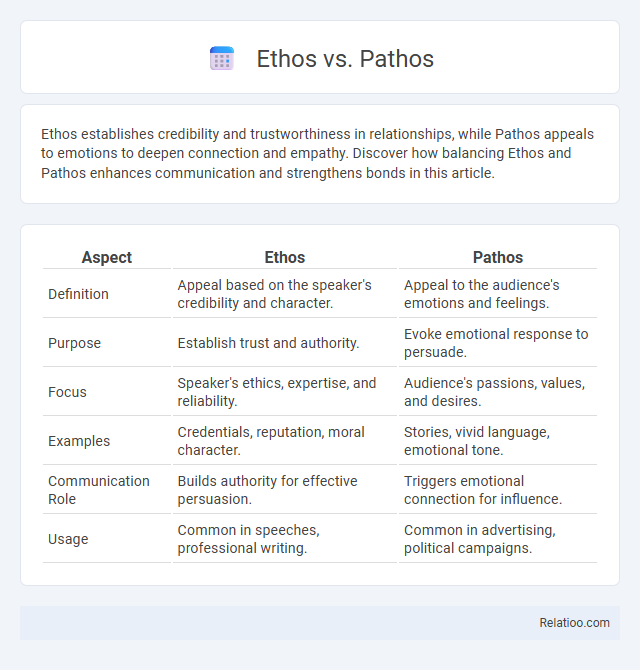Ethos establishes credibility and trustworthiness in relationships, while Pathos appeals to emotions to deepen connection and empathy. Discover how balancing Ethos and Pathos enhances communication and strengthens bonds in this article.
Table of Comparison
| Aspect | Ethos | Pathos |
|---|---|---|
| Definition | Appeal based on the speaker's credibility and character. | Appeal to the audience's emotions and feelings. |
| Purpose | Establish trust and authority. | Evoke emotional response to persuade. |
| Focus | Speaker's ethics, expertise, and reliability. | Audience's passions, values, and desires. |
| Examples | Credentials, reputation, moral character. | Stories, vivid language, emotional tone. |
| Communication Role | Builds authority for effective persuasion. | Triggers emotional connection for influence. |
| Usage | Common in speeches, professional writing. | Common in advertising, political campaigns. |
Understanding Ethos: Establishing Credibility
Ethos is a rhetorical strategy centered on establishing the speaker's credibility and trustworthiness to persuade an audience effectively. Demonstrating expertise, ethical character, and reliability enhances ethos and influences audience perception, making arguments more compelling. In persuasive communication, a strong ethos builds a foundation of authority that supports logical appeals and emotional connections.
Defining Pathos: Appealing to Emotion
Pathos is a rhetorical strategy that appeals directly to your emotions, aiming to evoke feelings such as sympathy, anger, or passion to influence your perspective. This technique leverages emotional triggers to create a connection between the audience and the message, making the argument more compelling and memorable. Understanding pathos enhances your ability to analyze persuasive communication and recognize when emotional appeals are being used effectively.
Key Differences Between Ethos and Pathos
Ethos and Pathos represent distinct rhetorical strategies in persuasion; Ethos appeals to the speaker's credibility and character, establishing trust and authority, while Pathos targets the audience's emotions to elicit feelings that support the argument. Ethos relies on ethical appeal and expertise, leveraging reputation and moral integrity, whereas Pathos uses emotional triggers like sympathy, anger, or happiness to influence decision-making. Understanding the key differences between Ethos and Pathos enhances persuasive communication by balancing logical credibility with emotional engagement.
The Role of Ethos in Persuasive Communication
Ethos plays a crucial role in persuasive communication by establishing the speaker's credibility, trustworthiness, and ethical character, which encourages the audience to accept the message. Building ethos involves demonstrating expertise, honesty, and goodwill, which enhances the speaker's authority and persuasiveness. Strong ethos fosters audience confidence, making the overall argument more compelling and influential.
Harnessing Pathos for Emotional Impact
Harnessing pathos involves appealing directly to the audience's emotions to create a strong, memorable connection that influences their beliefs and actions. Emotional storytelling, vivid imagery, and relatable experiences enhance pathos by evoking feelings such as empathy, fear, or joy. Effective use of pathos increases persuasion by making arguments more compelling and motivating audiences toward intended outcomes.
Ethos vs Pathos: When to Use Each
Ethos appeals to credibility and character, making it ideal for establishing trust and authority in professional or academic contexts. Pathos targets emotions, effectively motivating audiences by connecting on a personal or emotional level, often used in advertising or storytelling. Choosing between Ethos and Pathos depends on the goal: use Ethos to build trust and Pathos to inspire action or empathy.
Examples of Ethos in Real-World Scenarios
Ethos is demonstrated in real-world scenarios through the credibility of speakers like doctors endorsing health products or CEOs presenting company visions, establishing trust with their audience. For example, when a well-known scientist advocates for climate change policies, their expertise lends authority to the argument. You can leverage ethos by highlighting your qualifications and experience to build trust and persuade effectively.
Pathos in Action: Case Studies and Analysis
Pathos in action leverages emotional appeals to influence audiences by connecting with their values, desires, and fears, enhancing persuasive impact significantly. Case studies such as Martin Luther King Jr.'s "I Have a Dream" speech demonstrate how vivid imagery and heartfelt language evoke empathy and inspire collective action. By understanding how Pathos drives emotional engagement, Your communication strategies can be optimized to foster stronger connections and motivate desired responses.
Ethos and Pathos in Modern Marketing
Ethos in modern marketing leverages brand credibility, expert endorsements, and ethical practices to build consumer trust and authority. Pathos appeals to emotions by crafting compelling narratives, using imagery and storytelling that evoke feelings of happiness, fear, or nostalgia to influence purchasing decisions. Combining ethos and pathos creates powerful campaigns that resonate authentically and emotionally with target audiences, driving higher engagement and conversion rates.
Balancing Ethos and Pathos for Persuasive Writing
Balancing Ethos and Pathos in persuasive writing strengthens your argument by combining credible, ethical appeal with emotional connection. Establishing Ethos involves demonstrating expertise and trustworthiness, while Pathos engages the audience's feelings to motivate action. Your persuasive impact increases when logical credibility supports emotional resonance, ensuring your message is both believable and compelling.

Infographic: Ethos vs Pathos
 relatioo.com
relatioo.com